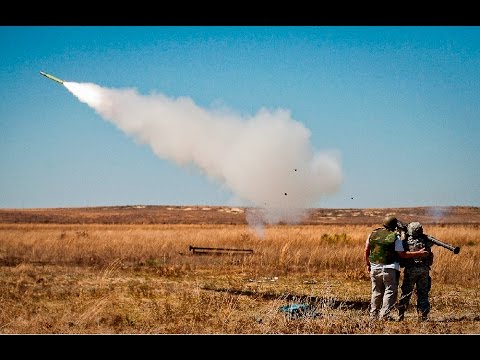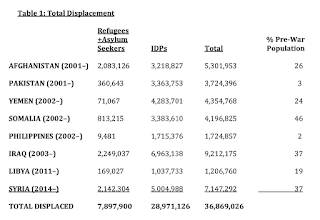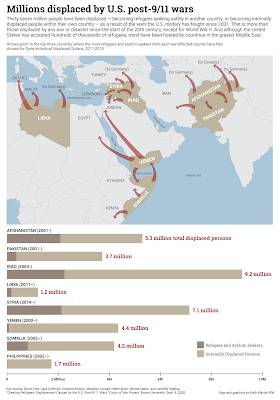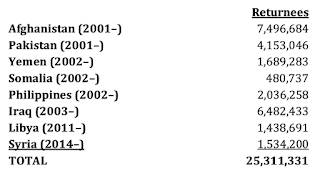
A recent study by the Costs of War group at Brown University examines the high cost of the seemingly endless War on Terror on the population of nations that have born the brunt of Washington's moves to crush its enemies since the attack of September 11, 2001. While the War on Terror is receiving absolutely no coverage by the mainstream media, it is an issue that has the potential to impact the western world since anger against the United States is being created by these actions which are allegedly intended to protect us.
Here is a key quote from the paper that outlines the importance of the study:
"Wartime displacement (alongside war deaths and injuries) must be central to any analysis of the post-9/11 wars and their short- and long-term consequences. Displacement also must be central to any possible consideration of the future use of military force by the United States or others."
The authors open by noting that since the Bush II administration announced the War on Terror 19 years ago, the United States has fought in wars or participated in combat operations in at least 24 nations. These wars have had a very high human cost that Washington seems quite capable of ignoring. Civilians have been forced to flee for their lives from air strikes, bombings, artillery fire and drone attacks among other events which has created both refugees and internally displaced people (IDP).
With that background, let's look at some statistics. The authors calculated the total number of displaced people in eight of the most significant wars in which U.S. forces have been involved since September 11, 2001. These include the Afghanistan/Pakistan and Iraq wars for which Washington is clearly responsible for initiating armed combat, the wars in Syria and Libya for which Washington was responsible for escalating and the conflicts/wars in Yemen, Somalia and the Philippines for which Washington was responsible as a participant through the use of drone strikes, battlefield advising, arms sales and logistical support among other means.
Here is a table showing the total displacement for the eight aforementioned wars as well as the percentage of each nations pre-war population that has been displaced:
These conservative estimates of displaced people could be far higher given that many refugees are not officially registered and are not counted as refugees by the United Nations High Commissioner for Refugees. Using expanded estimates in the number of displaced people for Afghanistan and Syria could bring the total to between 48 million and 59 million. In addition, as shown in this quote from the paper, the United States government has been substantially involved in many conflicts that are not included in the total:
"The U.S. government has employed combat troops, drone strikes and surveillance, military training, arms sales, and other pro-government aid in countries including Burkina Faso, Cameroon, Central African Republic, Chad, Democratic Republic of the Congo, Kenya, Mali, Mauritania, Niger, Nigeria, Saudi Arabia (related to the war in Yemen), South Sudan, Tunisia, and Uganda.72 In most of these countries, the U.S. military and allied European forces have backed national governments’ counter-insurgency campaigns and “counter-terrorism” operations against Islamist militants and other insurgents. In Burkina Faso, for example, there were more than half a million incidents of displacement in 2019; by year’s end, around 560,000 Burkinabe were living as IDPs. In Mali, 208,000 were living as IDPs by the end of 2019 as a result of years of violent conflict.73 Since 2001, U.S. combat troops have operated in every single one of the ten countries now suffering from the most severe internal displacement in the world, according to IDMC. The Central African Republic joins Burkina Faso and Mali in the top three. The rest of the top ten include Niger, Chad, Cameroon, the Democratic Republic of the Congo, as well as Somalia, Syria, and Yemen."
Here is a graphic showing the outflows and inflows of displaced people:
On the upside, if there is one, the authors of the study note that 25.3 million people have returned to their countries of origin as shown here:
It is important to keep in mind that many of these returnees are children that were born while in exile and are returning to homes that they have never known. As well, many have returned because they were deported by their host nation or because they could not afford to live in their host nation because the cost of living was much higher than they could afford.
Let's close this posting with a final quote from the paper:
The displacement documented in this paper, along with the wars’ death toll and other intersecting forms of harm, cannot simply be dismissed or normalized as “unintended consequences” or “collateral damage.” The displacement and other suffering must be central to any analysis of the post-9/11 wars and to any conceivable consideration of the future use of military force by the United States or any other country. The legitimacy and efficacy of war should be questioned more than ever given nearly two decades of disastrous outcomes. One must also ask what steps the U.S. government, U.S. citizens, and other responsible parties have taken—and what steps they will take—to repair and make amends for the damage inflicted on the 37 million or more people displaced by the post- 9/11 wars.
Click HERE to read more from this author.
You can publish this article on your website as long as you provide a link back to this page.




Be the first to comment